To lower your soap's pH naturally, try adding citric acid during rebatching, using lemon juice or vinegar as gentle acidifiers, incorporating borax in liquid soaps, utilizing rainwater instead of tap water, infusing herbs like hibiscus or chamomile, allowing proper curing time (4-6 weeks minimum), adding acidic additives at trace, monitoring with a pH meter rather than strips, adjusting your superfat percentage, or using tartaric acid. The right balance maintains cleansing power while remaining gentle on your skin.
10 Best Homemade Methods to Lower Soap Ph
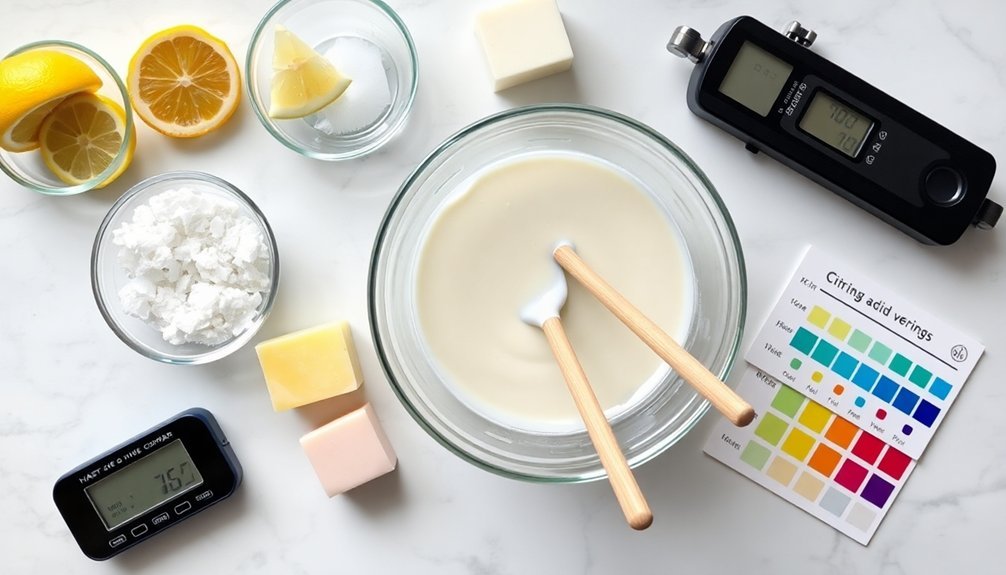
While commercial soaps typically have a pH between 9-10, you can effectively lower this alkalinity using several homemade methods.
Citric acid dissolved in water during rebatching is perhaps the most reliable approach, but you'll need precise measurements to preserve your soap's quality.
For a gentler approach, try adding lemon or lime juice to slightly lower the pH without compromising the soap's properties.
Vinegar and tartaric acid represent alternative acidic additives worth experimenting with for different results.
Remember that monitoring the pH throughout your process is critical.
Too much acidity can cause fatty acids to precipitate, diminishing cleansing effectiveness.
If you're working with liquid soap formulations, consider borax as a neutralizing agent that reduces pH while enhancing viscosity, though availability may vary by region.
Understanding the Natural Ph of Handmade Soap
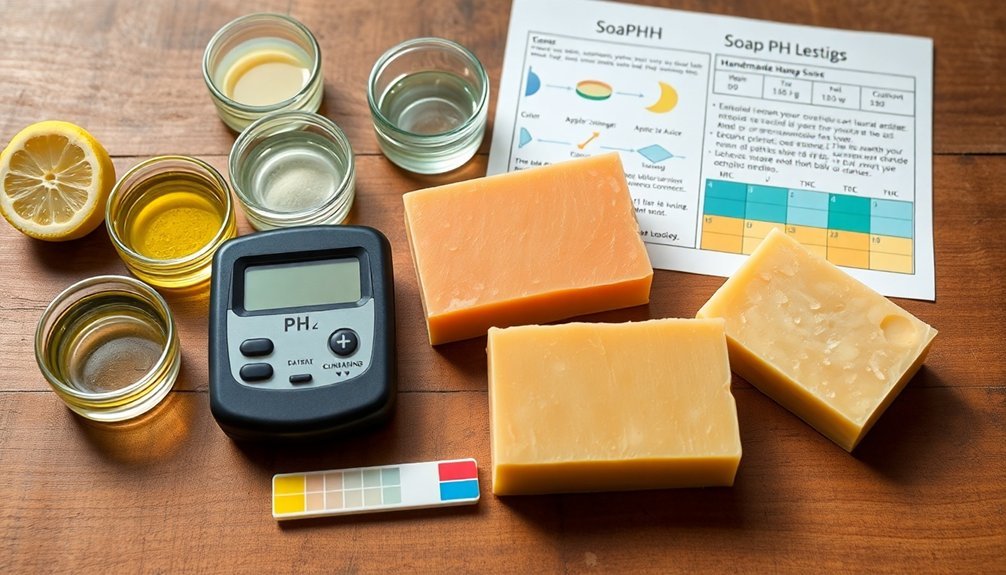
Handmade soap naturally registers between 9-12 on the pH scale, making it considerably more alkaline than your skin's ideal pH of around 5.5.
You'll find that this alkalinity stems from the lye required in saponification, though a well-cured soap with proper superfat levels becomes milder over time.
Your soap's final pH can be influenced by several factors including oil choices, cure time, and additives like citric acid or vinegar that may help bring it closer to skin-friendly levels.
Natural Ph Measurement Basics
Before attempting to lower the pH of your handmade soap, you'll need to understand what you're starting with. Handmade soaps typically have a pH between 9 and 12, with 10 being generally acceptable if the soap doesn't "zap" when tested.
While many soap makers rely on pH test strips for quick results, these aren't always reliable for soap testing. A pH meter provides much more accurate readings when working with soap's unique properties. This precision becomes essential when you're adding citric acid or other acidifiers to lower pH.
Remember that testing isn't just about numbers – it helps guarantee your soap is skin-safe and effective.
However, be cautious about attempting to lower pH below 6.5-7.5, as this can cause your soap to break down into fatty acids.
Alkalinity vs. Skin Care
The natural pH of your skin hovers around 4.5-5.5, creating an acidic barrier that protects against bacteria and environmental damage.
This delicate balance can be disrupted by handmade soaps, which typically have a pH of 9-12.
While this alkalinity makes soap effective for cleaning, it can compromise your skin's acid mantle, leading to dryness and irritation.
This is especially concerning for sensitive skin conditions like atopic dermatitis or for infants.
You'll want to lower the pH of soap closer to your skin's natural level, but not below 6.5, which would cause the soap to fail.
Remember that your skin naturally returns to its normal pH after washing, but repeated exposure to high-alkalinity products can weaken its protective barrier over time.
Factors Affecting Soap Ph
Understanding your soap's pH begins with recognizing that several key factors influence its alkalinity. Traditionally made soap naturally maintains a pH between 9 and 12, with most quality soaps hovering around 10. This alkaline nature is vital for effective cleansing.
The amount of lye used in your recipe directly impacts pH levels. Unreacted lye can push your soap toward the higher end (pH 12), potentially causing skin irritation. Conversely, adding acidic ingredients like citric acid can lower pH, but proceed with caution—dropping below 6.5-7.5 will cause your soap to break down into fatty acids, rendering it ineffective.
When formulating soap recipes, remember that proper pH balance achieves both cleansing power and skin compatibility. Testing is essential before introducing additional pH-modifying ingredients to guarantee your soap remains functional.
Citric Acid: the Most Effective Natural Ph Reducer
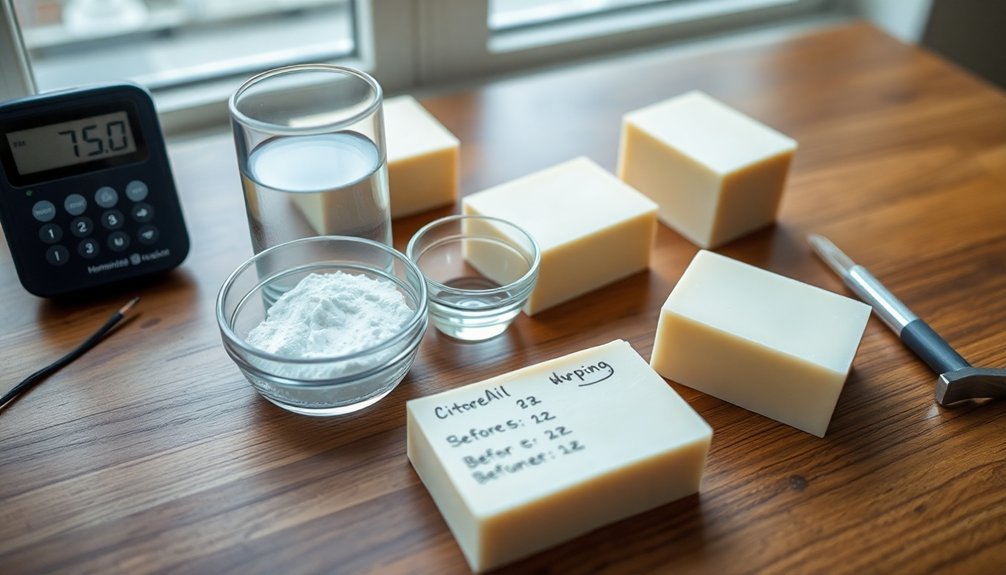
Soapmakers worldwide recognize citric acid as the gold standard for naturally reducing soap pH. When used correctly, this natural acid effectively lowers your soap's pH, creating a gentler product that's more compatible with your skin's natural balance.
To incorporate citric acid into your natural soap, mix it with a non-saponifying oil before adding it to your soap mixture. This prevents interference with saponification while still achieving pH reduction.
Be cautious—excessive amounts can cause your soap to revert to fatty acids, compromising its cleansing ability.
You'll need to experiment to find the perfect amount for your specific formula, as different oils respond uniquely to citric acid. Monitor pH carefully after adding dissolved citric acid, accounting for granule solubility which may affect your measurements.
Vinegar and Lemon Juice Additions During Rebatching
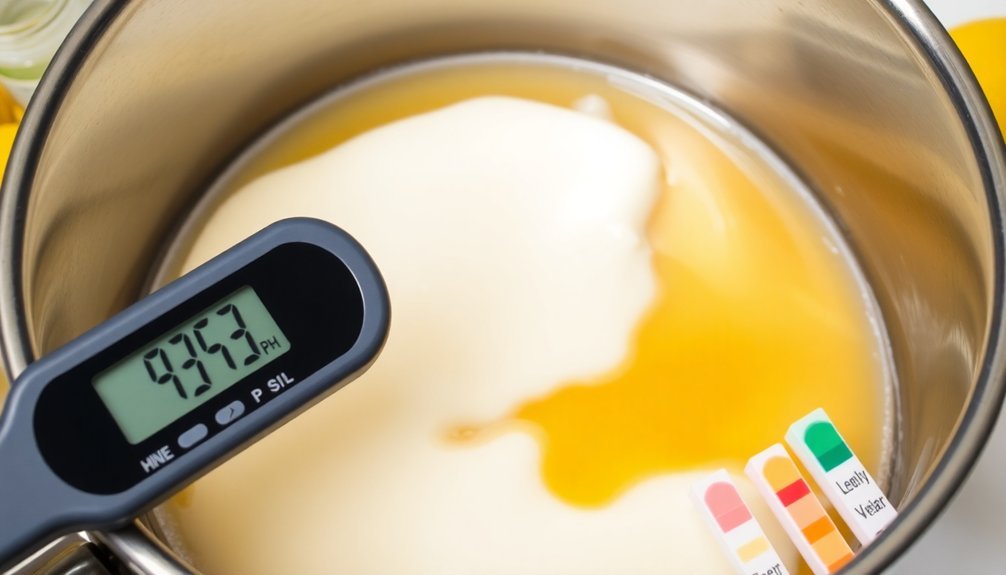
While citric acid offers precision in pH adjustment, another approach awaits those who prefer working with rebatched soap. You can incorporate vinegar or lemon juice during the rebatching process to lower the pH of your handmade soap, making it gentler on skin.
| Acidic Agent | Recommended Amount | Effect on Soap |
|---|---|---|
| White Vinegar | 1-2 tsp per pound | Neutralizes alkalinity without cloudiness |
| Apple Cider Vinegar | 1 tsp per pound | Adds beneficial properties while reducing pH |
| Lemon Juice | ½-1 tsp per pound | Contains natural citric acid for effective pH reduction |
| Vinegar Rinse | Post-soap treatment | Surface pH adjustment without affecting structure |
Monitor your soap's texture closely—too much acid can transform your creation into sludge. Start with small amounts and test regularly to find the perfect balance that maintains cleansing properties while achieving your desired pH level.
Rainwater vs. Tap Water: Impact on Final Soap Ph
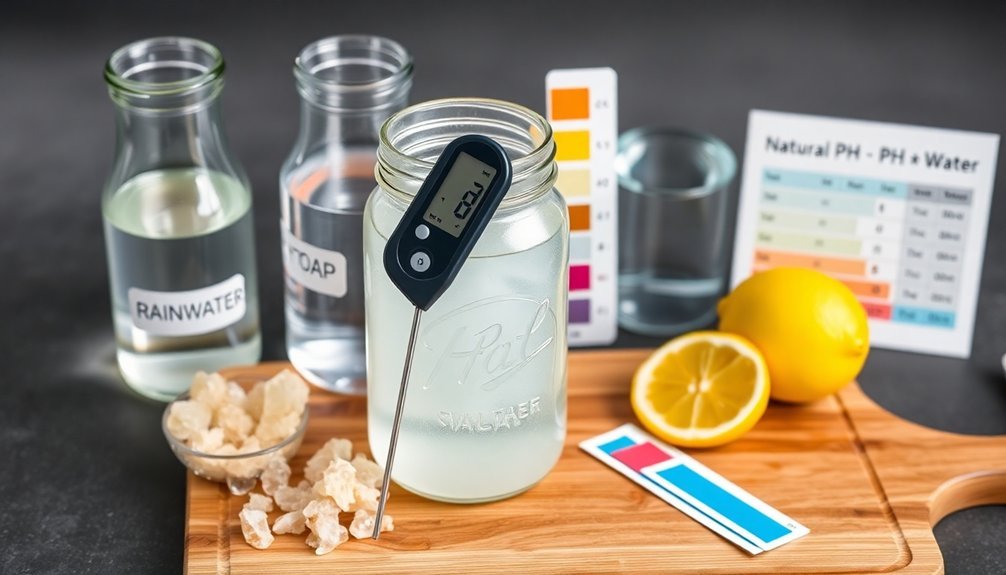
The water you choose for your soap-making process greatly influences the final pH of your product. Rainwater typically has a naturally lower pH than tap water, making it an excellent choice for soap making when you're aiming for a gentler final product.
- Rainwater's naturally lower pH means less adjustment work in your soap formulation, saving you time and ingredients when balancing your recipe's acidity.
- Tap water often contains minerals that raise soap pH and create soap scum, potentially causing skin irritation and reducing lather quality.
- You'll want to test both water sources before beginning your project, as local conditions can profoundly affect pH levels in both rainwater and tap water.
Always consider your water source as a key ingredient, not just a carrier fluid.
Buffering Soap Ph With Herbal Infusions
Herbal infusions offer a natural way to buffer your soap's pH while adding skin-nourishing benefits that commercial additives can't match.
You'll want to select herbs with naturally occurring acids like hibiscus, chamomile, or calendula, which create effective buffer solutions when properly infused in your soap base.
To brew effective pH-lowering infusions, steep your chosen herbs in distilled water for 24 hours, strain thoroughly to remove all solids, and substitute this liquid for the water in your soap recipe.
Herbal Infusion Selection Guide
Selecting three to five strategic herbs for your infusions can considerably impact your soap's final pH level while enhancing its skin benefits.
When choosing herbs for pH adjustment, consider their natural acidity levels—hibiscus and chamomile are excellent options that effectively lower pH while contributing beneficial properties to your soap.
For ideal results with your herbal infusion:
- Test hibiscus first – With its higher natural acidity, it provides significant pH reduction while adding a subtle pink hue.
- Combine chamomile with calendula – This pairing offers moderate pH adjustment plus anti-inflammatory properties.
- Document your experiments – Record steeping times, herb-to-liquid ratios, and resulting pH changes to refine your formulations.
Remember to steep your dried herbs for several hours to extract the active compounds that will influence your soap's final pH balance.
Brewing Effective Buffer Solutions
While commercial pH adjusters have their place, brewing your own herbal buffer solutions offers a natural alternative that won't compromise your soap's integrity.
To create effective herbal infusions, steep your chosen herbs in hot water for 10-20 minutes, then strain the liquid carefully before adding it to your soap mixture.
Different herbs provide varying levels of buffering effect—chamomile not only soothes skin but contributes to a slightly lower pH while enhancing your soap's properties. Green tea offers similar benefits with its own unique profile.
Always test the pH after incorporating your infusion to verify it remains within the 9-10 range necessary for proper cleansing.
You'll want to experiment with different herbs to discover which provides the ideal balance between buffering effectiveness and beneficial properties without sacrificing your soap's cleansing power.
Using Natural Acidic Additives at Trace
When you're aiming to create gentler, skin-friendly soap, natural acidic additives introduced at trace offer an effective way to lower your soap's pH.
To make this work, dissolve citric acid in a non-saponifying oil before adding it to your soap batter. This controlled approach helps reduce the pH without disrupting saponification.
- Lemon or lime juice can be added directly at trace, but monitor your soap's consistency and lather as you adjust quantities.
- Citric acid solutions work most effectively when precisely measured – start with small amounts (0.5-1% of oil weight).
- Different oil formulations require varying amounts of acid to reach your target pH – keep notes during experimentation.
The Cold Process Method: Ph Monitoring and Control
When making cold process soap, you'll need to regularly test pH levels with a calibrated pH meter rather than relying on potentially inaccurate test strips.
You can incorporate citric acid during the mixing phase to lower the naturally high pH (around 12) that occurs when lye reacts with oils.
Remember to add acidic ingredients cautiously and document your results, as excessive amounts can destabilize your soap and compromise its cleansing properties.
Ph Testing Fundamentals
Understanding the fundamentals of pH testing remains vital for successful cold process soap making, since the saponification process naturally alters pH levels over time. Properly cured soap typically reaches a pH between 9-12, which is normal and safe for most skin types.
When you're trying to lower the pH, accurate measurements are important before making adjustments with citric acid or other acidic additives.
- Always invest in a quality pH meter rather than pH strips, as strips often provide unreliable readings when testing soap.
- Check the pH at multiple stages during the curing process, as levels will change markedly from initial saponification through completion.
- Test consistently using the same method—dissolving a small soap sample in distilled water—to guarantee your measurements are comparable over time.
Citric Acid Integration
Now that you've mastered pH testing, let's focus on using citric acid as a pH modifier in cold process soap making.
For successful integration, always dissolve citric acid in a non-saponifying oil rather than directly in your lye solution. This prevents interference with saponification and guarantees proper pH adjustment.
Precision is essential when lowering the pH of your soap. Measure carefully—excessive citric acid can revert your soap back to fatty acids, compromising its cleansing properties.
Aim for a final pH range of 9-10 to maintain effectiveness while improving skin compatibility.
Remember that pH changes may not be immediately apparent after adding citric acid. The full effect becomes evident only after curing is complete.
Begin with small test batches to determine the best concentration before adjusting the amount of lye or citric acid in your full-sized recipes.
Hot Process Techniques for Lower Ph Formulations
Although achieving a balanced pH in homemade soap can be challenging, hot process soapmaking offers several effective techniques for creating milder, lower pH formulations.
When working with sodium hydroxide, timing is essential—add dissolved citric acid during the final cooking stages to avoid disrupting saponification.
- Monitor the pH of your soap throughout cooking, as levels change while lye is consumed during saponification.
- When rebatching, grate your soap base and melt with minimal water before incorporating acidic additives.
- Add a small amount of olive oil during rebatching to help neutralize remaining lye, potentially lowering pH from 12 to 8.
For natural alternatives, try incorporating lemon or lime juice, but carefully measure to prevent unwanted reactions that could compromise your soap's quality.
Curing Time's Effect on Soap's Ph Balance
Proper curing represents another powerful way to influence your soap's pH beyond hot process techniques.
When you first unmold your soap, it typically has a high pH of 10-12, which can irritate sensitive skin. As you allow your soap to cure for 4-6 weeks, the saponification process continues, gradually reducing the pH level.
Don't rush this critical step. Insufficient curing time leaves unreacted lye in your bars, keeping the pH unnecessarily high and potentially causing skin irritation.
Properly cured soap will stabilize around pH 9-10, indicating complete saponification and safe skin use.
You'll benefit from monitoring pH throughout the curing process to refine your formulations.
This patience-requiring method costs nothing but time and gives you valuable insight into how your specific recipe behaves during the complete saponification cycle.
Frequently Asked Questions
How to Reduce the Ph of Soap?
To reduce your soap's pH, you can add citric acid or lemon juice during rebatching. You'll also lower pH by incorporating olive oil to neutralize excess lye. Always monitor pH levels to maintain soap integrity.
What Household Item Can I Use to Lower Ph?
You can use lemon juice, vinegar, or cream of tartar from your kitchen to lower pH. Add these acids gradually and test as you go to avoid making your solution too acidic.
What Happens if the Ph of Soap Is Too High?
If your soap's pH is too high, you'll experience skin irritation, reduced cleaning power in hard water, and soap scum formation. It's especially problematic if you have sensitive skin conditions like eczema or dermatitis.
What Is the Easiest Way to Lower Ph?
To lower pH easily, you'll want to incorporate citric acid mixed with non-saponifying oil into your soap. You can also use lemon juice or rebatch with citric acid solution. Always test with a pH meter afterward.
In Summary
You've now got 10 effective methods to lower your soap's pH naturally. Whether you're using citric acid, vinegar, lemon juice, or adjusting your water source, you'll create gentler soap for sensitive skin. Remember, proper curing time and careful pH monitoring throughout your process are essential. With these techniques, you'll craft beautifully balanced soaps that care for your skin while still providing effective cleansing.

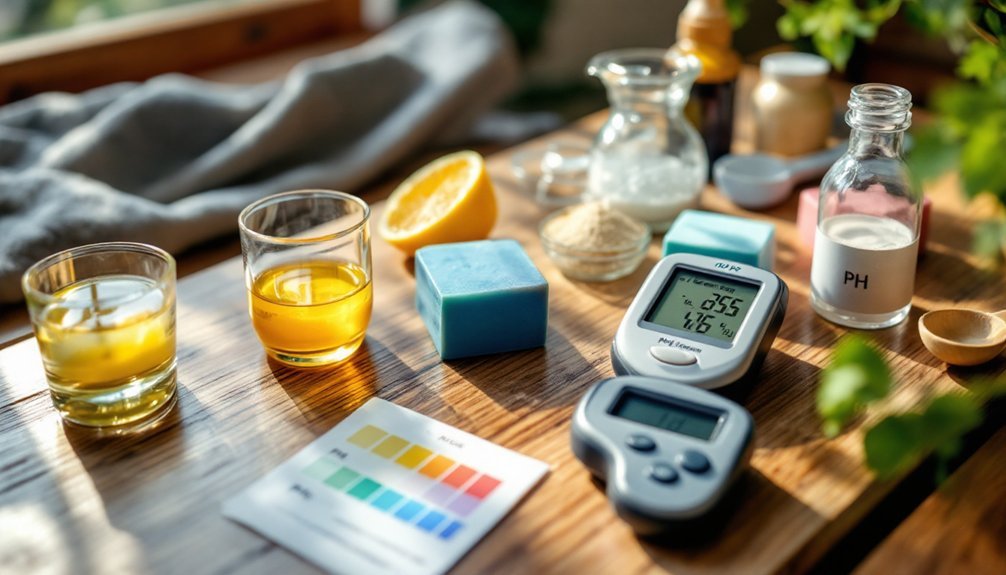



Leave a Reply